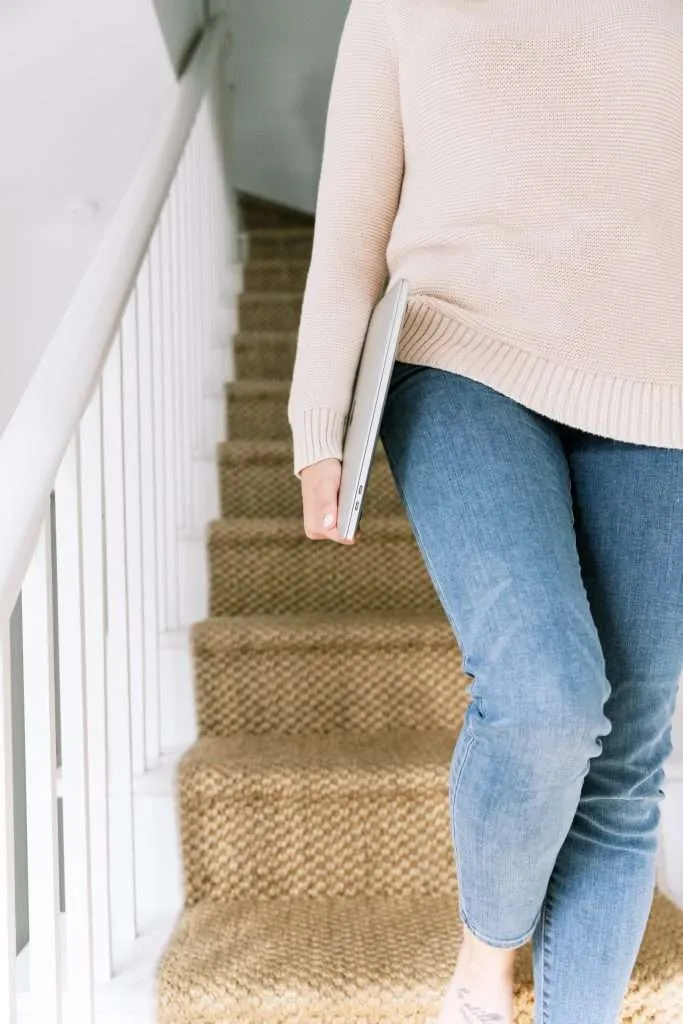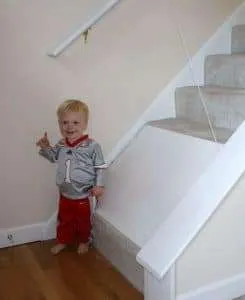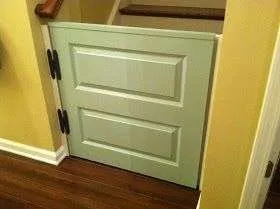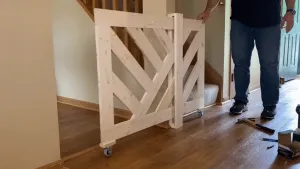9 DIY Baby Gates: How to Block Your Stairs Without Compromising Style!
As a new mom, I know that feeling of being overwhelmed when it comes to keeping your little one safe. One area where this can definitely be challenging is in protecting them from accessing stairways and steep stairs.
But you’ve got a gorgeous staircase and home aesthetic you don’t want to disturb with an unsightly plastic baby gate!
This post may contain affiliate links. For my full disclosure policy click here.
It can seem like an impossible task without the addition of bulky baby gates – but fear not! I’ve covered several creative ways to build DIY baby gates. There are actually plenty of ways you can block stairs with minimal effort or cost, and I’m here to share some simple methods with you today!
So grab yourself a cup of coffee, get comfortable, and let’s dive right into discovering some DIY baby gates that will keep those steps off-limits for your curious cutie.

Size Up Your Situation
Before choosing materials and designing your homemade baby gate, take some measurements of the space you want to block off.
Consider factors like:
– Width of the opening – standard is around 36 inches.
– Architectural features like banisters.
– How much room you need to comfortably pass through.
Measuring will allow you to select materials and customize the gate to suit your unique space.
Upholstered Stair Baby Gate
These are upholstery fabric fastened by crafted inner components like rigid plastic verticals, durable and strong horizontal pieces of webbing, and knots to pull up a barrier to block the stairs. With tension, these barriers can be quite strong.
These can be installed at the bottom of your stairs, regardless of what is on either side of the stairs. It will work with banisters and walls alike. They can then be taken down by simply slipping the fabric off the attached hook.
There is also a subtype of stair barrier that is less expensive and can be made at home. It’s called the simple fabric gate.
To create this, the following will be needed:
1. Some quilting fabric
2. Iron seams
3. Four cord bundles (eight if available in an easier reach)
4. Some bias fabric (will be preferable if they are sewn into a tape-like structure)
Steps to create a simple fabric stair baby gate
- Measure the length and height of the stairs you’re attempting to block off and cut the fabric to meet those measurements. Add about an inch to each measurement so you’ll have enough fabric to fold over at the edges.
- Cut the iron on seams to the same length and width from step 1.
- Iron these on the outline of the fabric stair gate. If you’d like to add some additional strength to the end of the iron ons, you can sew a few stitches at the corner.
- Put the bias fabric through the edges and iron again.
- Space the cord bundlers evenly across the left or right side of your fabric bottom of the stairs baby gate. Add one more across the bottom if you’d like to keep them from crawling under!
- You’re ready to keep your little Houdini from finding their way upstairs!

Plexiglass Glass Baby Gate
These are made from petroleum-based thermoplastic and are made to be non-toxic. These are used in place of popular baby gates because of their easy maintenance, strength, and weather resistance.
Plexi glasses are even used in big transparent aquarium tanks, and they withstand water pressure, thereby ensuring parents and guardians there is minimal risk of shattering.
These take a bit of DIY work but with a drill and a sharp utility knife, you should be able to knock it out in an afternoon. You can even get the folks at your hardware store to cut the wood pieces if you don’t have access to a saw.
These can be painted to match the rest of your interior so they don’t detract!

Stair Blockers
These are boards shaped to fit in the stairs so that stairs become impossible for the child to climb up. These are a great option for those with open stairs. They are easy to put on and remove.
These are less obstructive and will not affect the house decoration. BUT be careful because they can be easily looked over and you could take a ride down the last 2 steps!
The site that originally made these is no longer in use but they can be made by buying a pair of stair runners, cutting to fit your desired length, and adding a top sheet of plywood or plexiglass on top.

PVC Pipe Baby Gates
These are less expensive plastic forms of barriers to block stairs. They are non-toxic and maintenance-free. Though they are lightweight, they can endure many forces.
These are a little more complicated than the other solutions but can absolutely be done by a somewhat handy person. There are lots of YouTube videos out there walking through the steps, this is one of the better ones.
Barn Door Baby Gate
If your home has that lovely farmhouse design, these bottom-of-the-stairs baby gates can be a great solution! With function and aesthetics, you’re sure to love them.
The caveat being they are a more involved and difficult DIY project. But don’t let that deter you if you’ve got the farmhouse or cottage home design, these are worth the day of building!

Half Door DIY Baby Gate
They are referred to as Dutch doors, split or double-hung doors in some regions. Each half door is a typical standard door divided into two but swings independently.
However, if you’ve got an old door laying around you could cut it in half and convert it to a baby gate with the addition of hinges and a latch.

Net barrier
Just like the fabric material, the net barrier works in the same principle. There are different types of nets, and the thickness depends on the age of the child. Net barriers are susceptible to being pulled off if the holes between them have more space. Therefore, a more closely knit net is advised.

Sliding mini doors
Imagine having doors tailored specifically to your stairway, seamlessly sliding left or right whenever needed while providing a foolproof safeguard for your little ones and furry friends! This innovative design not only simplifies controlling the opening and closure but also lends a touch of elegance to your home.

Plywood Barriers
Plywoods are materials produced by an industrial combination of different layers of thin woods to form a single sheet. They are lightweight and are less expensive.
Plywood barriers will destroy if hit too much with force but are cheap and available in most markets. There are also limited color textures of plywoods if the house owner cares about color coordination.

Make DIY Baby Gates a Memorable Family Project
Creating homemade baby gates is a great opportunity for family bonding. Get the whole crew involved!
– Add your child’s name or handprints with acrylic paint pens to personalize wooden or fabric gates.
– Have an arts and crafts decorating party to let kids help pick colors and prints for gates.
– Give older siblings special jobs like fetching tools or holding materials to build their sense of responsibility.
– Capture the process in photos and videos to look back on later.
Conclusion: How to Block Stairs Without a Baby Gate
You’ve now seen there are some great options when it comes to building a DIY baby gate. When selecting which mode works best for you, make sure you consider the size of the area, materials available, and ability level. Investing a little bit of time and effort can save you money whilst also allowing you to select a design that will be unique to your home.
Having a safe environment where your little one can explore is essential and with the right baby gate in place, they will remain safe while still being able to hang out on their own two feet. Not only that, but these days baby gates don’t have to be dull – adding some accessories or decorating them gets your creative juices flowing and adds a touch of style to any room.
Finally, remember that implementing safety precautions in the home can create peace-of-mind for both parent and child while ensuring everyone has enjoyment and security in equal parts!
What can I use instead of a baby gate?
There are lots of DIY options for making a baby gate if you don’t want to purchase one of the plastic ones. From fabric to plexiglass to a barn-style door. If you or someone you know is handy, this can be made in an afternoon.
How do you baby-proof open stairs?
There was a site that sold these but they no longer do. They can be made with a pair of stair runners cut to your desired length and attaching a sheet of finished plywood, plexiglass, or plastic top sheet.
Do I really need a baby gate?
It is strongly recommended that you have a baby gate for all stairs. It only takes a momentary lapse in attention for your baby to take a dive down the stairs! And that’s something no parent wants!
Having the peace of mind that your child is safe is also worth it’s weight in DIY materials!


